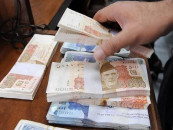New tax measures: PML-N stretches the net to help banks avoid taxes
On the contrary, tax burden on salaried, non-corporate business classes has risen substantially.

The decision to reduce the rates was taken to appease bankers who are considered very close to the new government. CREATIVE COMMONS
In the new tax measures proposed in the Budget 2013-14, the Pakistan Muslim League-Nawaz government has provided an opportunity to the banks to avoid billions of rupees in taxes by reducing the rate of dividend income earned by investing in treasury bills and the stock market through asset management companies from 35% to 25%.
The top five banks of the country have grown their bottom-line over the years by making risk-free lending to the government through bonds and T-bills and earning double-digit returns. The federal government had become a desperate borrower and that allowed the banks to pile up big fortunes.

The move by the government is contrary to the claims of taxing the rich to overcome the economic crisis as it has increased the tax burden on the salaried class by a third, while the tax burden on the non-corporate business class – also known as association of persons – has grown three-fold.
The new tax measures are likely to fuel speculation that the PML-N government does not treat all segments of the society equally and always tilts in favour of the corporate class of the country.
Through the Finance Act 2013, the government has proposed to reverse the rates of dividend income that had been increased in the previous budget aimed at plugging loopholes that the bankers were successfully exploiting.
According to the finance bill, “the rate of dividend income earned by banks from Money Market Funds and Income Funds, and gain from disposal of shares of listed companies within one year of acquisition is proposed to reduce from 35% to 25%”. It has proposed amendment to the seventh schedule of the Income Tax Ordinance to give effect to the decision.
The Federal Board of Revenue had taken the decision of increasing taxes to end the practice of banks using asset management companies for transactions to dodge taxes worth billions. Since the corporate tax rate was 35%, the big banks were investing through asset management companies.
The country’s two leading banks were involved in re-routing their funds to these asset management companies for investing in government securities to evade taxes, compelling the government to increase the rates.
The sources said the decision to reduce the rates was taken to appease bankers who are considered very close to the new government. Federal Board of Revenue Chairman Ansar Javed was not available for comments.
In the outgoing fiscal year, the federal government borrowed Rs2.024 trillion, almost the entire amount from the domestic market. For the next fiscal year, however, the government has projected a deficit of Rs1.651 trillion and only Rs169 billion will be borrowed from abroad as budgetary support while the rest will be arranged from domestic sources.
At a time when the government reduced the tax burden on the banking sector, it significantly increased income tax rates for the salaried class and non-corporate business class.
Against income tax rates ranging from 10% to 25% of taxable income, the federal government has proposed to increase the rates up to 35% for the association of persons. This has resulted in additional tax burden ranging from 33% to 215% for this class.
Those non-corporate businesses whose annual earning was up to Rs750,000, the tax burden on them will be doubled. For the category of Rs750,000 to Rs1.5 million, the tax burden will be increased by another 59%. For Rs1.5 million to Rs2.5 million, tax liabilities have been increased by 43%, for Rs2.5 million to Rs4 million, tax liabilities will increase by a third, for Rs4 million to Rs6 million, the burden will increase by 106% and the Rs6 million to Rs8 million income slab will bear an additional tax burden of 215%.
Similarly, for the salaried class, the tax burden had been increased by up to a third. As compared to other income groups, tax liabilities of the highest income group of over Rs10 million will increase by 33% followed by the second highest income group of Rs7 million whose liabilities will increase 24%.
Due to uneven rates, the tax liabilities of the lowest income group having annual income of Rs400,000 to Rs500,000 will be increased by 22% when compared with the liabilities of this year.
Published in The Express Tribune, June 15th, 2013.
Like Business on Facebook to stay informed and join in the conversation.



















COMMENTS
Comments are moderated and generally will be posted if they are on-topic and not abusive.
For more information, please see our Comments FAQ